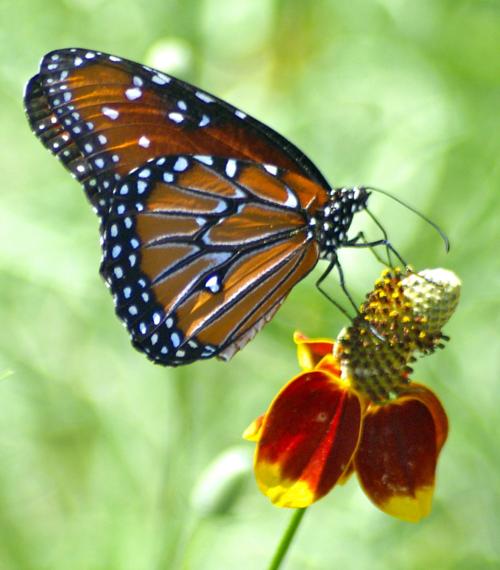Did you ever wonder how a butterfly gets around? Its erratic flight and speed would seem to make it difficult to escape its predators, find a mate, or even locate food.
Flowering plants use visual cues to attract butterflies for pollination and they in turn are rewarded with nectar for their efforts. This is called a symbiotic relationship. Plants that do not depend on insect or bird pollination usually do not have showy or scented flowers.
To attract the potential pollinator to a particular blossom the plant must present a visual contrast, either in form or coloring. Sometimes we can see these patterns and colors, but often they are in the ultraviolet range we humans cannot see, but the butterflies and other pollinators can.
Butterflies vary widely in their sensitivity to light, and are considered to have the widest visual range of any form of wildlife. Cones in the butterfly ommatidia perceive color with different types of color receptors that allow the eye of a butterfly (or birds, some fish, and some reptiles) to see a larger spectrum of colors than the normal human eye. Our eyes perceive a different and smaller set of colors than those of the butterfly. Butterflies can see in many of the colors that we can, but they can also see ultra violet.
To the human eye, many butterflies appear the same, but the butterflies themselves can often identify each other quite easily using ultraviolet markings. The ultraviolet patches on some butterflies are directionally iridescent, so that they appear to flicker in flight. This flickering is thought to have an important role in butterfly behavior and communication.
Even though butterflies tend to avoid the color green when feeding they are attracted to it during egg laying. And not just any green, only the green from the host plants that will provide food for the young caterpillars.
Butterfly eyes are composed of thousands of image formingtiny eyes called ommatidia. Each ommatidium is a sensory structure with a lens, cones, and retina cells. The ommatidia are arranged in the compound eye so that each individual eye is set at a slightly different angle from the next. This arrangement allows the butterfly eye to simultaneously see in all directions at the same time with a mosaic of individual images that form a whole picture. You have heard of surround sound, just think of what it would be like to have surround vision!
Different species of butterflies may see different colors. Some of these differences in the ability to perceive various colors likely impact how each species sees and interacts with their environment. One butterfly may have an easy time seeing a particular colored flower while another species may not.
Summary
Butterflies can see in amazing color and their eyes reveal a nearly 360-degree view of the world around them, even if the picture isn’t entirely clear. They are able to look at the flower they are probing with their proboscis, a butterfly flying to their right, and the approaching predator behind them at the same time giving it a chance to escape and meet the perfect mate.




